The Musicarta Canon Project Module One
Thirds in the Right Hand
This is Module One of the Musicarta Canon Project. In this module you will start building your Canon performance by learning the ‘thirds in the treble’ and playing around with them to produce a performance like this.
Tip: Start your Canon Project sessions with some D major scale work, and get a backing track like CBT_01 or a classical Canon recording ready and set up to play along with.
The key of D
Watch the mini D major introductory video if you do not already know the key of D major well.
There is a complete Key of D major supplement in the Workbook with more in-depth teaching material and a scale-of-D practice programme. Work through the scale patterns to improve your finger dexterity, or if you keep forgetting which black keys to use.
Thirds in the treble
Using just the index fingers (pointing fingers) of both hands, pick out the following string of double notes (thirds) on your keyboard.

The right hand plays the top (higher) note, the left hand plays the bottom (lower) note.
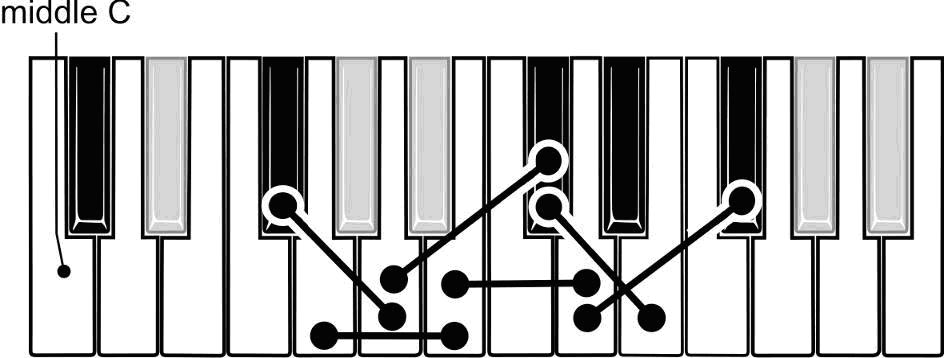
Playing the simple thirds over a backing track will sound like this.
'Thirds'
These pairs of notes are called thirds because they encompass three note-names – three letters of the musical alphabet.

The counting of intervals – pairs of notes – is done by counting the note-names from one note to the other, so you start from one, not zero.
Memorising the string of thirds
Use all the clues you’ve got to memorise
these pairs. One clue is the way the pairs ‘slant’. Because the black keys are
further away from you, black key/white key pairs slant one way or the other.
Here is the music again, with lines above showing the slant of the pair of
notes.

Watch the video, which runs through all three of these learning techniques.
Work through the three suggested techniques, more than once.
Remember, here you're 'listening' from left to read, like reading a line of text.

Imagine four dots on your desktop or use the illustration in the Workbook, and rehearse the pairs of notes, ‘seeing’ the black and white keys of the scale of D major as you tap through the string of thirds.
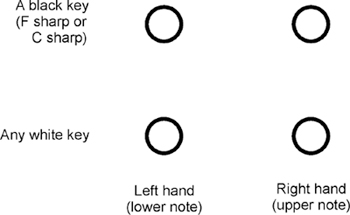
Working away from the keyboard like this will help you learn the notes.
Then play along with your recording again and watch the slant of the thirds change.
Next, we will explore some simple ‘thirds’ variations.
Breaking up the thirds
Break up the thirds into top-bottom pairs and play top-bottom-top-bottom in time with the music.
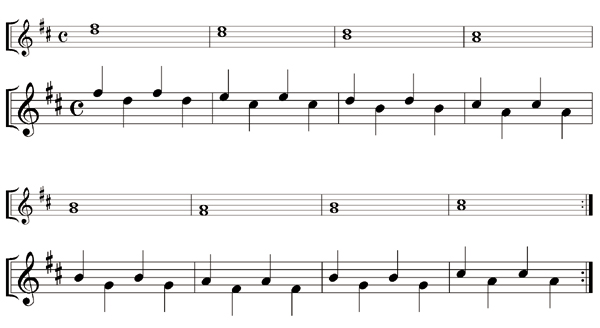
The original string of thirds is shown reduced
just for reference: you only play the larger second and fourth lines.
Playing next-door scale tones
We can easily embellish our thirds using next-door scale tones in the right hand. The right hand uses the D major scale tone immediately above its ‘third’ tone, like this.

Once you start playing like this, you can’t keep using just one finger in the right hand. The music gives a suggested fingering. You don’t have to follow it exactly, but you should avoid running out of fingers or using your thumb on a black key.
The audio and MIDI performance files from
here on are slowed down to practice tempo to help you learn the pattern.
Remember, you can slow down the performance still more in MidiPiano while you’re
learning.
The pattern with a different rhythm
We can make this pattern more interesting by making our next-door scale tone shorter.
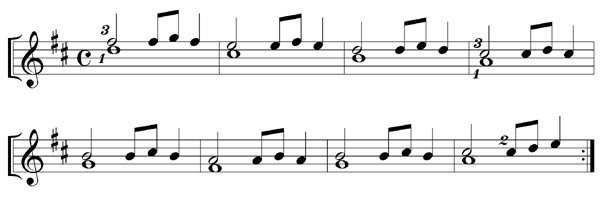
Note the right hand ‘tweak’ in the last bar before the chords start repeating. ‘Formula’ patterns often sound better if you change a note or two here or there (the ‘tweak’).
Double the number of left hand notes
We can continue to develop the pattern by doubling up the left hand notes.

Look out for more tweaks in bar 7 (right hand) and bar 8 (left hand).
Audio challenge: Further Variations
Listen to these two audio clips and try to play the music you hear.
The first variation has fewer notes in the
right hand, the second one has more, but always the same next-door-above scale
tones. See if you can play the variations from just the audio clips, or check your work with the video performances in 'Answers' at the bottom of the page.
Here are two more patterns separated out from the module performance.
Try to play them by ear. Listen carefully, trying to hear
- how the upper note goes up and down,
- how long the lower notes last and
- which of the upper notes they come with.
You can use any of the instrumental backing tracks to practice these thirds patterns over. Play the backing track in Windows Media Player with ‘repeat’ switched on, or load it into Audacity and press shift+spacebar to get the ‘loop’ (repeat) going.
Here is the module performance again.
Practice the patterns until you can play along with the performance files and your backing track, then try playing the patterns up to speed with your classical recording in the background.
With practice, you will be able to play all these thirds-based treble variations. Get creative and put together your own performance by combining the elements in a different order, along with any other variations you might have discovered.
When you’re ready, go on to Module Two, where you learn the bass line – the roots of the Canon chords. You don’t have to complete every single task to move forward
Answers
Here are the 'play by ear' variations.
Type One is the same as the last variation you played, but the second right hand note is tied to the first – it doesn’t sound separately.
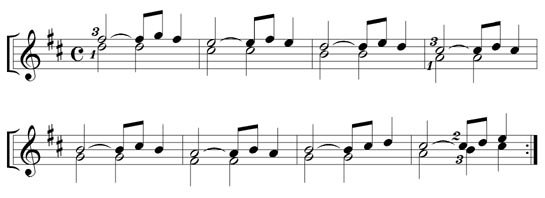
Type Two still uses the same notes, but changes more often.
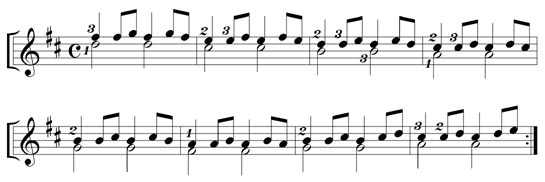
Here are two more thirds patterns from the module performance. No music for these, but they are very similar to what you have played already.
Keep practicing your scales!
All music is in a certain key. At the piano, this means using some of the black keys instead of some of the white keys. These black keys are indicated in the key signature at the start of a line of keyboard music.
To be the musician you want to be, you will need to be able to play in several keys, and playing scales is a tried and tested way of learning the right piano keys to use. Learning scales is not just another hoop to jump through – it’s about becoming a better, freer musician.
The Canon is in D major, which is an easy scale to learn and a model for all the ‘sharp key’ scales (G, D, A, and E majors). Ideally, you would start all your Canon Project study sessions with some D major scale practice. The Key of D Major supplement contains a wealth of scale practice patterns to keep your practice interesting and progressively build your ability.
Top musicians can play notes on their chosen instrument quickly, one after another. Practicing scales and finger exercises is the only way of acquiring this finger dexterity. Do it for yourself, and, if possible, put in the hours early on in your musical career.
|
OUT NOW! |
THE MUSICARTA BEAT & RHYTHM WORKBOOK At last! An effective approach to keyboard rhythm & syncopation skills. Learn more! |
ONLY $24.95! |
THE MUSICARTA
|
The MusicartaA methodical approach to keyboard syncopation for
|
PUBLICATIONS
exciting keyboard
creativity courses
CHORDS 101
WORKBOOK

~HANON~
video course

Musicarta
Patreon
PENTATONICS
WORKBOOK
video course

Creative Keyboard
video course

BEAT AND RHYTHM
WORKBOOK

- Volume 1 -

12-BAR PIANO
STYLES WORKBOOK

MUSICARTA MODES
WORKBOOK

PIANO STYLE

CANON PROJECT
video course

VARIATIONS
video course


- Piano Solo -
video course

- Piano Solo -


YouTube playlists





 THE LOGO
THE LOGO
